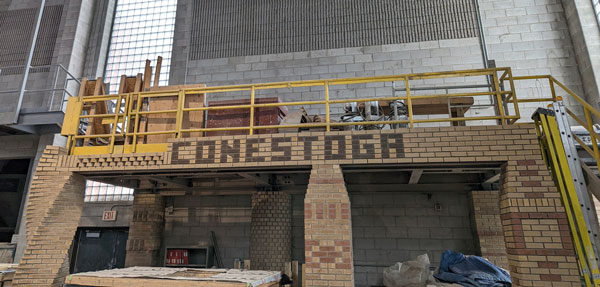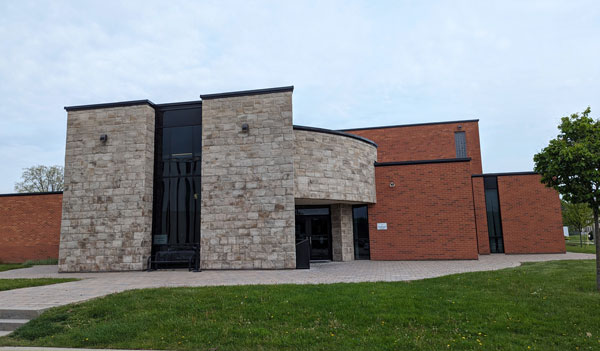Judging by the demand Conestoga College receives from employers, the masonry trade is one high school graduates or people considering a career change might want to consider.
Since 2008, the college has been providing brick and stone training in its dedicated masonry centre, an approximately 930-square-metre purpose-built building at its Waterloo, Ont. campus.
“There are more employers looking to hire than we have available graduates. We receive consistent feedback from our industry stakeholders that they need a greater labour force,” says Jeff Willsie, a chair in the school of trades and apprenticeship.
The training is offered in two different platforms: a 5,600-hour Red Seal brick and stone apprenticeship and a one-year, two-semester post-secondary certificate.

In the apprenticeship division, the apprentice, the sponsor (or employer) and the Ministry of Labour, Immigration, Training and Skills Development enter into a three-way contract to provide the apprentice the training they need to prepare them to write a Certificate of Qualification exam.
Most of the training for the apprenticeship occurs on the job, but embedded within those 5,200 hours are three levels of in-school training at the centre. Each level consists of 240 hours and is delivered in eight week-blocks. Apprentices are required to pass each level before proceeding to the next one.
Once the apprentice has successfully completed the hours and the schooling, they may apply to write the national Red Seal exam to receive their licensing as a brick and stone mason.
Not everyone can immediately secure a sponsor and that is the purpose of the post-secondary certificate. It’s basically a pre-apprenticeship program that provides students with some skills and knowledge which would enable them to secure a sponsor employer and enter into an apprenticeship contract, says Willsie.
To be eligible, potential candidates require an Ontario Secondary School diploma or equivalent to apply to the college.

The curriculum of the certificate program is mapped or aligned to the first level of the apprenticeship program and offers the student the opportunity to be exempt from the Level 1 training once they secure an apprenticeship.
But that is not always the case. Some students may still choose to enter that first level or be required to do so by their employer, says Willsie.
Asked about the composition of the training, he says it’s a 50-50 balance of theory and hands-on practical learning. The courses taught include masonry safety, masonry theory, masonry practices, mathematics for the trades, college reading and writing skills, and entrepreneurship.
In the masonry theory courses, the students study the safe and proper use of industry-related tools, equipment, materials and best practices that adhere to provincial codes as they apply to various sectors of the brick and stone industry such as restoration, refractory, residential and industrial/commercial/institutional.

In the hands-on portion, the students are taught how to safely operate tools and materials in a shop as well as how to read and understand drawings and estimate the amount of materials needed for a project.
As they gradually develop physical skill sets and become more comfortable and proficient with tools and materials, they begin constructing projects on both an individual basis and as part of a group.
“The projects are intended to simulate real life applications,” he says.
Licensed brick and stone masons, some of whom still maintain a presence in the industry, teach the courses.
“We rely heavily on them to deliver the content of our programming.”
Enhancing the nature of the courses is the masonry centre itself, which was constructed with the support of the Ontario Masonry Contractors Association, the Canadian Concrete Masonry Producers Association, the Ontario Masonry Training Centre and several individual contractors.
“The building is an architecturally complex building with several curved walls and arches that display some of the intricate and complicated details that the industry has to offer,” says Willsie.
Some of its features include a large open training room, offices and a dedicated classroom filled with displays and props designed to support learning.
Besides the training at the centre, the college also collaborates with regional school boards to develop and deliver dual credit programs designed to provide high school students with an entry into the trade. In these programs, the school students complete college level courses that offer high school credits towards their diploma. One of those programs is a 42-hour masonry course.
“It’s a fun and interactive way to get high school students exposure to the masonry trade at an introductory level,” he adds.
Depending on the needs of the school board, Conestoga will either host classes of high school students or deliver the masonry programming at the high school itself.
When the students come to the campus they obtain insight to the trade and get a taste of what college life is like, says Willsie.
“The dual credit programs have been wonderfully successful across many trades and masonry is no exception. We often see students that take a dual credit masonry course come back for the construction techniques — brick and stone certificate program.”



Recent Comments
comments for this post are closed